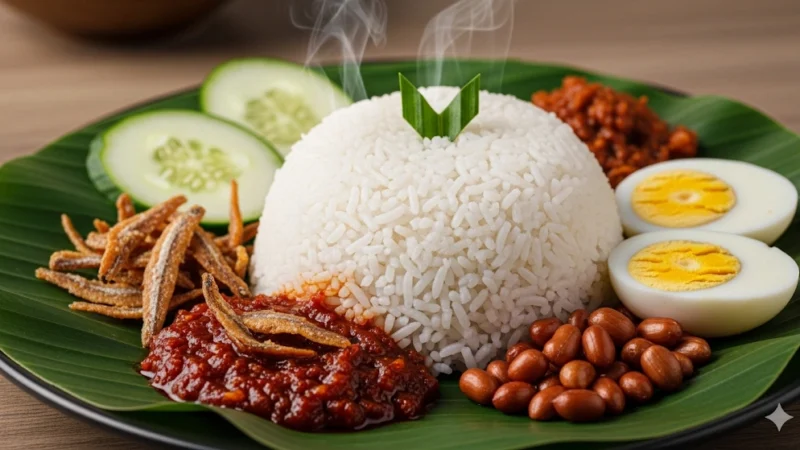Nasi Lemak

Nasi Lemak: Malaysia’s national dish, fragrant coconut rice served with sambal, fried anchovies, boiled egg, cucumber, and peanuts.
Nasi lemak is a fragrant rice dish cooked in coconut milk and pandan leaves, traditionally considered the national dish of Malaysia. It’s a popular Malay dish, often enjoyed for breakfast, and is also widely available in Singapore and Southern Thailand. The dish typically includes a side of sambal (spicy chili paste), fried anchovies, peanuts, cucumber, and a fried egg.
Food Item: Nasi Lemak (The name comes from the Malay terms for “rice” and “creamy-rich,” referring to the use of coconut milk.)
Origin: Malaysia. It is considered the national dish of Malaysia and has roots dating back to the late 19th century. It is also a native dish in neighboring countries and territories, including Singapore, Brunei, parts of Southern Thailand, Indonesia, Christmas Island, and the Cocos (Keeling) Islands.
Category: A main course, most commonly eaten for breakfast but also popular for lunch, dinner, or supper. It is also a staple of street food culture.
Appearance: The dish consists of white rice cooked with coconut milk and pandan leaves, often wrapped in a conical pocket of banana leaf. It is traditionally served with a variety of accompaniments, including sambal, fried anchovies, peanuts, sliced cucumber, and a hard-boiled or fried egg.
Ingredients:
Rice: White rice, coconut milk, pandan leaves, and salt. Some recipes also include ginger and lemongrass for added aroma.
Sambal: Chili paste made from dried chilies, shallots, garlic, dried shrimp paste (belacan), and sometimes tamarind juice and sugar.
Accompaniments: Fried anchovies (ikan bilis), roasted peanuts, hard-boiled or fried egg, and sliced cucumber.
Common additions: Fried chicken, beef rendang, fish curry, or vegetables like kangkong (water spinach).
Preparation: The rice is cooked in a rice cooker or on a stovetop with coconut milk, pandan leaves, and salt. The accompaniments are prepared separately. The sambal is a key component, requiring a paste to be made from blended ingredients and then cooked down.
Equipment: Basic kitchen equipment such as a rice cooker, stovetop, frying pan, and a wok is sufficient. Traditionally, the dish is served on banana leaves.
Variations:
Regional: In northern Kedah, a version known as Nasi Lemak Kuning (yellow nasi lemak) is served with curry. In Indonesia, seafood is often added.
Cultural: Malaysian Indian versions may be served with chicken, fish, or lamb curry, while Chinese versions might include non-halal ingredients like luncheon meat.
Modern: Contemporary variations include Nasi Lemak, burgers, sushi, and gourmet versions featuring premium ingredients like lobster or wagyu beef.
Taste: A complex, harmonious blend of flavors. The rice is rich, creamy, and fragrant with a nutty sweetness from the coconut milk. The sambal provides a spicy, tangy, and slightly sweet kick, contrasting with the salty anchovies, savory peanuts, and fresh cucumber.
Texture: The rice is fluffy and moist. The accompaniments provide a satisfying crunch from the fried anchovies and peanuts, a crisp freshness from the cucumber, and a smooth, rich texture from the egg yolk.
Aroma: The dish is highly aromatic, with the scent of coconut and pandan leaves being the most prominent. Frying the anchovies and cooking the sambal also releases a pungent, savory, and spicy aroma.
Sound: The sizzling of ingredients during preparation and the satisfying crunch of the fried anchovies and peanuts while eating.
Cultural Significance: Nasi Lemak is a powerful symbol of Malaysian identity, transcending ethnic and social boundaries. It is a common unifying dish that embodies the country’s multicultural heritage and agrarian roots. The traditional banana leaf wrap also represents an eco-friendly practice.
Symbolism: The dish symbolizes unity and cultural fusion, as its different components from various culinary traditions come together to form a unique and beloved national dish.
Regional Cuisine: A core part of Malay cuisine, it is also found throughout Southeast Asia, particularly in Malaysia, Singapore, and Brunei.
Social Context: Nasi Lemak is an accessible, everyday food, widely available at roadside stalls (where it is often sold in small packets) and hawker centers. It is a staple of communal dining and is enjoyed by people from all walks of life.
Nutritional Information: The dish can be high in calories, with a typical serving ranging from 473 to over 1000 calories, depending on the side dishes. It is a source of carbohydrates, protein, and fat.
Health Benefits: The dish’s components offer some nutritional benefits, such as medium-chain triglycerides (MCTs) in coconut milk, healthy fats and fiber in peanuts, and protein and Omega-3 fatty acids from anchovies.
Dietary Restrictions: The traditional dish is not suitable for vegans or vegetarians due to the use of anchovies and eggs. However, it can be adapted by substituting these with plant-based alternatives and using a vegetable-based sambal.
Allergens: Common allergens include peanuts, fish (anchovies), and eggs.
Cost: Generally very affordable, especially the basic roadside stall version. Prices vary depending on the location and additional side dishes.
Production: It is produced by both small-scale home cooks and large restaurants, as its preparation requires simple, widely available ingredients.
Sustainability: The traditional use of banana leaves for wrapping makes it an environmentally friendly option.
Availability: Widely available and can be found at all times of the day, not just for breakfast.
History: The dish was first mentioned in a dictionary in 1875 and a book in 1909, initially serving as a hearty meal for farmers. It has since evolved to include a wider range of accompaniments.
Anecdotes: Many Malaysians and Singaporeans share fond memories of Nasi Lemak being a childhood favorite, a comfort food, or a go-to meal for any time of the day.
Personal Connection: For many, Nasi Lemak is more than just food; it is a source of nostalgia and a connection to their culture and home. It is a dish that evokes a sense of comfort and identity.
Must Try Restaurant: Village Park Restaurant (Damansara Uptown, KL)









Comments are closed.